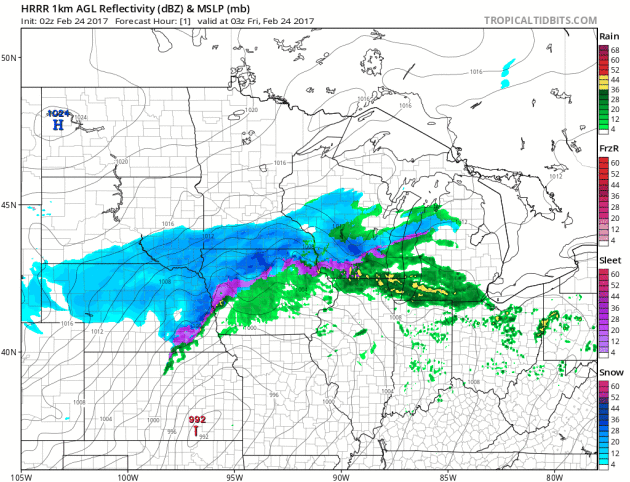+11.5 F. Twin Cities temperatures are averaging 11.5 F. warmer than average in February, to date.
39 F. high temperature in the Twin Cities Thursday.
32 F. average high on February 23.
40 F. maximum temperature on February 23, 2016.
February 24, 1835: The temperature at Ft. Snelling falls 26 degrees in only three hours.

0 to 2" Metro - Blizzard Conditions Just South of MSP
Mea culpa. Another well-publicized near-miss. Because it now takes an act of CONGRESS to get a big snow in the immediate Twin Cities. Snow enthusiasts are crushed (again) - spring lovers breathing a collective sigh of relief. Not much in-between.
In 20-20 hindsight I should have stuck to my guns. "What are you doing forecasting a 'couple inches' of snow?" e-mailed The Weather Channel's Mike Seidel earlier this week. He's the trained professional who stands outside during TV weather live shots.
Which reminds me of my first TV weather gig, WNEP-TV in Wilkes-Barre/Scranton, Pennsylvania. The news director smirked and said "Paul, if you're outside doing the weather at least you'll get the current weather right."
The ECMWF (European) model had the right idea all along, keeping the heavy snow bands south of MSP. NOAA's models took longer to catch up, but now all the simulations show very little snow for the immediate metro (advisory posted southern suburbs), with a foot or more and white-out conditions closer to Rochester and I-90. So close.
But no, it doesn't want to snow here anymore.
No more near- misses in sight, maybe a little rain by next Tuesday. Nothing arctic brewing, just 30s and a few 40s.
HRRR high-resolution model above showing sharp cut-off on the northern edge of the snow shield courtesy of NOAA and Tropicaltidbits.com.

GFS Had Right Idea. The ECMWF (European) model has done the best job with today's would-be storm for the Twin Cities, consistently pushing the axis of heaviest snow south of MSP. There is some speculation that a storm over Florida may have prevented the Midwest storm from amplifying enough to push heavier snow farther north, but the GFS solution (above) did a better job than NAM and WRF simulations. The "Euro" still does a better job most days - a fact that doesn't make me happy. But data suggests it's true.
The Milding of February: All-Time Winter Warmth in Midwest. 60s and 70s as far north as Milwaukee on Wednesday? Bob Henson puts things into perspective in an article at Category 6: "...Wednesday’s warmth was a fitting coda to a remarkably warm stretch across most of the Midwest. In some ways, the ultra-mild period is reminiscent of the Great Warm Wave of March 2012, if not quite as spectacular as that summerlike spell was. Duration is one of the most impressive aspects of the past week’s Midwestern mildness. St. Cloud, Minnesota, saw its sixth consecutive day above 50°F on Wednesday, the longest such streak on record for any February, while Chicago, Illinois, set a similar record for its first six-day streak of 60°F readings in any February (or in any winter month, for that matter). Rockford, Illinois, set six daily record highs in a row on February 17-22. Each of these new records was between 66°F and 70°F, beating out previous records that ranged from 58°F to 64°F..."

Winter Flashback Upper Mississippi Valley. NOAA's 12 KM NAM model shows the swirl of snow, ice and rain pushing across southern Minnesota and Wisconsin into the Great Lakes. Strong to severe T-storms push into Detroit, Cleveland and Columbus (unusually far north for February) and the next smear of rain and snow pushes across the Pacific Northwest, with more showery rains for California.
- 636 inches at the Mount Rose ski area in Nevada.
- 584 inches at Boreal Mountain.
- 556 inches at Kirkwood, including 80 inches this week.
- 544 inches at Heavenly, including 81 inches this week.
- 534 inches at Northstar, including 84 inches this week (61 inches in 48 hours).
- 510 inches at Mammoth..."
"1-in-100 Year Flood Event" for Northern California. The Los Angeles Times has more details.
14,000 in San Jose Flee High Water. KQED News has the story.

Photo credit: Kevin Ho // CC BY-NC-SA 2.0
Today's Infrastructure Plans Must Account for Tomorrow's Technology. Infrastructure needs to be upgraded, but what's the smartest, most cost-effective way to plan for future modes of transportation? Here's an excerpt from TheHill: "...General Motors CEO Mary Barra, who also serves as one of President Trump’s economic advisors, often says that the next five years will see more change in mobility than have the past 50 years. If she is right — and we think she is — we have some work to do. The nation’s current transportation system largely operates as it did some 60 years ago when President Eisenhower signed the National Interstate Highway Act into law. Ford CEO Mark Fields, who serves as an advisor to President Trump on manufacturing, recently wrote in Medium, “Longer term —15, 20 and even 30 years out — we’re imagining a world with significant concentrations of autonomous vehicles, most of which will be electrified...”
St. Paul file photo: Dan Anderson, Flickr.
Photo credit: "A family homestead in the pilot-project village in Kenya." Credit Andrew Renneisen for The New York Times.
TODAY: Winter Weather Advisory for southern suburbs. Gusty with snow, 0-2" metro". Over a foot southeastern MN with blizzard conditions. Winds: N 15-30+ High: 28
FRIDAY NIGHT: Few flakes - snow tapers southeastern MN and western WI. Low: 18
SATURDAY: Chilled sun, winds slowly ease. Winds: NW 10-20. High: 32
SUNDAY: Patchy clouds, pretty quiet. Winds: SW 5-10. Wake-up: 23. High: 36
MONDAY: Intervals of sun, milder than average. Winds: S 5-10. Wake-up: 27. High: 41
TUESDAY: Light rain or mix possible. Winds: S 7-12. Wake-up: 31. High: near 40
WEDNESDAY: March comes in like a lamb. Gray skies. Winds: NW 10-15. Wake-up: 26. High: 37
THURSDAY: Weak clipper, few flurries possible. Winds: NW 10-15. Wake-up: 21. High: 32
Climate Stories....
It Might Feel Good, But February's Intense Heat is a Very Bad Sign. Which makes it a little harder to fully enjoy these freakish February warm fronts. ThinkProgress reports: "...This
change in weather patterns does not come without a cost. For those
living in frigid Midwestern states, a balmy day in February is a welcome
respite from the typical winter chill. But the early thaw — what
scientists call “season creep” — can have disastrous consequences for ecosystems. Flowers are already beginning to emerge in Chicago, which has gone a record 67 days without an inch of snow. Early blossoms may wilt before they can be pollinated. Farmers in the region may see their crops bud after an early thaw only to perish in a late-season frost..."
Map credit: "Plants are regrowing leaves days or weeks earlier than they typically do." CREDIT: National Phenology Network

Why You Shouldn't Hope for an Early Spring. Here's a clip from Ensia: "...Some
of the longest running records, which chronicle first leaf growth of
honeysuckle and lilacs across the lower 48 states, show a noticeable
shift toward earlier dates since the 1980s. Like the temperatures
recorded as part of climate change research, the leaf-out dates show
great variability from year to year but the trend is distinct — earlier
warmer temperatures and earlier first buds and blooms. While occasional
false springs are not new, what is new in recent years is the
combination of increasingly warmer springs and extreme temperature
swings, overall shorter times throughout fall and winter of
below-freezing temperatures, and the altered precipitation patterns
associated with global climate change..."
Weather Whiplash. Parts
of southern Minnesota went from 60s to a blizzard in a couple of days;
it seems the extremes are trending more extreme over time. Hunter
Cutting explains at Medium: "...We
see the signs of warming everywhere: in temperature readings, satellite
measurements, disappearing sea ice, vanishing glaciers, melting ice
sheets, changing seasons, migrating species, and the accelerating rise
of the oceans as the seas warm and expand. At last count, there are more
than 26,500 such signals. We are now also living with dramatic changes
in extreme weather and its impacts. Extreme downpours, storm surges,
heat waves, droughts and wildfires have all been significantly amplified
by climate change, in some cases dramatically. These changes were
expected — a small shift in Earth’s climate produces a substantial shift
in extreme weather..."
Red State America Acts on Climate Change - But Calls It Other Names. If we focus on cleaner, cheaper, renewable American energy sources - the climate challenge may take care of itself. Here's an excerpt from Scientific American: "My colleagues and I did a survey of over 200 local governments in 11 states of the Great Plains region to learn about steps they’re taking to mitigate the effects of climate change and to adapt to them. We found local officials in red states responsible for public health, soil conservation, parks and natural resources management, as well as county commissioners and mayors, are concerned about climate change, and many feel a responsibility to take action in the absence of national policy. But because it is such a complex and polarizing topic, they often face public uncertainty or outrage toward the issue. So while these local officials have been addressing climate change in their communities over the past decade, many of these policy activities are specifically not framed that way..."
File photo credit: Associated Press.
Photo credit: "Michael E Mann, a climate scientist at Penn State University. ‘Michael has most certainly become a lightning rod,’ said MIT climate scientist Kerry Emanuel." Photograph: Supplied.
Republican Who Reversed His Position on Climate Change Thinks Trump Will Too. Here's the intro to a story at Fusion: "Former South Carolina Republican congressman Bob Inglis once received an award for believing in climate change. Now, the climate change convert who lost his 2010 re-election bid in part due to his reversal on the issue, thinks President Trump could make the same 180. In a speech in Australia on Wednesday, Inglis said that when Trump does things like call climate change a Chinese hoax he’s “channeling the fears of fearful people” and that he “couldn’t possibly believe that.” “Reality is what will force Donald Trump to shift and amend the chants at his rallies,” he said in the speech at the National Press Club in Canberra..." (AP image).
How Far To The Next Forest? A New Way to Measure Deforestation. Here's a clip from an interesting story at The New York Times: "...This
new metric, which the researchers named “forest attrition distance,”
reflects a particular type of forest loss: the removal of isolated
forest patches. When these patches are lost (a process the authors refer
to as attrition), adjacent forests become farther apart, potentially
affecting biodiversity, soil erosion, local climate and other
conditions. The authors calculated the change in total forest cover from
1992 to 2001, and found a loss of 3 percent or 35,000 square miles,
approximately the size of Maine. Over the same time period, Dr.
Mountrakis said, forest attrition distance increased by 14 percent, a
contrast he called striking..."
Map credit: "Maps that contrast changes in forest coverage in the United States, above, and the distance to the nearest forest, below." Credit Sheng Yang and Giorgios Mountrakis.
What Your TV Meteorologist Likely Thinks of Climate Change. Dr. Marshall Shepherd has a post at Forbes: "...One of the issues that always comes up is the assumption that all meteorologists are on TV. The Boston Globe article went on to talk primarily about broadcast meteorologists, which represent less than 10% of meteorologists yet the title said "many meteorologists." It is very common for the public to assume meteorologists are just on TV. I get the question, "what channel are you on?" all of the time. The AMS in conjunction with George Mason University recently surveyed its membership, which is far broader than just the small sample of broadcast meteorologists. According to a summary of the report on the AMS website,
The vast majority of members of the American Meteorological Society agree that recent climate change stems at least in part from human causes, and the agreement has been growing significantly in the last five years. According to a new survey of AMS members, 67% say climate change over the last 50 years is mostly to entirely caused by human activity, and more than 4 in 5 (80%) respondents attributed at least some of the climate change to human activity..."
Do You Know Someone Who Should Be Recognized for Climate Adaptation Efforts? The Minnesota Climate Adaptation Partnership (MCAP) will be recognizing outstanding climate adaptation work in Minnesota with awards to be presented on May 8, 2017, as part of the National Adaptation Forum. MCAP is joining the National Adaptation Forum in offering a conference that will present a range of practitioners who have experience with climate smart strategies for adapting to our changing climate. The conference titled Action today for a better tomorrow, will be held at the St. Paul River Centre, May 8-11, 2017. Awards will honor individuals, organizations, institutions and businesses that have provided exceptional leadership in education, research, policies, and practices to improve resilience and develop, advance, or implement climate adaptation strategies. Anyone may submit a nomination, which is very simple. The award nomination deadline is March 1, 2017, and nomination details are available on the University of Minnesota Water Resources Center web site:
https://www.wrc.umn.edu/news-events/climateadaptationconference
Graphic credit: "Northern California Sierra precipitation - average, previous wettest year, and 2016-2017." Illustration: California Department of Water Resources.
No comments:
Post a Comment